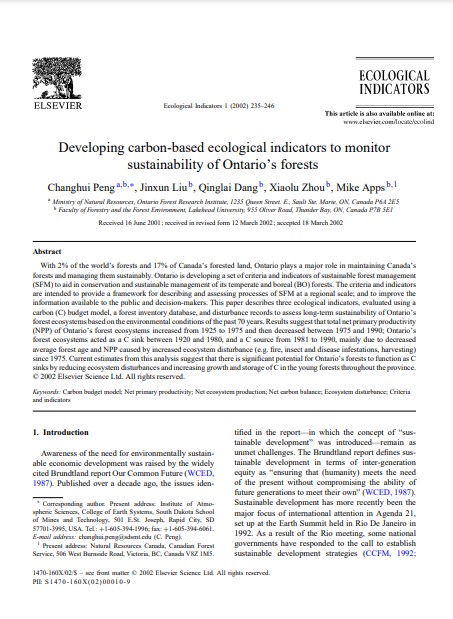Developing carbon-based ecological indicators to monitor sustainability of Ontario's forests
Bosque Modelo:
Lake Abitibi
Temática:
Gestión forestal
Tipo de documento:
Artículo científico
Resumen
With 2% of the world’s forests and 17% of Canada’s forested land, Ontario plays a major role in maintaining Canada’s forests and managing them sustainably. Ontario is developing a set of criteria and indicators of sustainable forest management (SFM) to aid in conservation and sustainable management of its temperate and boreal (BO) forests. The criteria and indicators are intended to provide a framework for describing and assessing processes of SFM at a regional scale; and to improve the information available to the public and decision-makers. This paper describes three ecological indicators, evaluated using a carbon (C) budget model, a forest inventory database, and disturbance records to assess long-term sustainability of Ontario’s forest ecosystems based on the environmental conditions of the past 70 years. Results suggest that total net primary productivity (NPP) of Ontario’s forest ecosystems increased from 1925 to 1975 and then decreased between 1975 and 1990; Ontario’s forest ecosystems acted as a C sink between 1920 and 1980, and a C source from 1981 to 1990, mainly due to decreased average forest age and NPP caused by increased ecosystem disturbance (e.g. fire, insect and disease infestations, harvesting) since 1975. Current estimates from this analysis suggest that there is significant potential for Ontario’s forests to function as C sinks by reducing ecosystem disturbances and increasing growth and storage of C in the young forests throughout the province.
Información Bibliográfica
Autor:
Peng, C, J Liu, Q Dang, X Zhou and M Apps.
Revista:
Ecological Indicators
Año:
2002
N°:
4
País :
Canadá
Páginas:
235 - 246
Volumen:
1
Idioma:
Ingles
Palabras claves
Carbon budget model; Net primary productivity; Net ecosystem production; Net carbon balance; Ecosystem disturbance; Criteria and indicators





